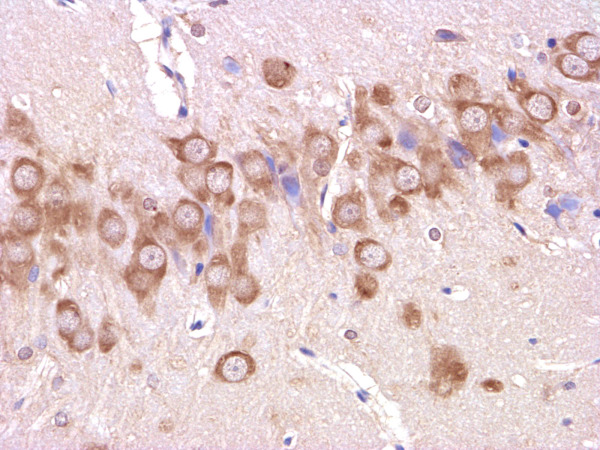
Western Blot Positive WB detected in: Hela whole cell lysate, A375 whole cell lysate, HEK293 whole cell lysate, Rat Brain whole cell lysate, Mouse Brain whole cell lysate All lanes: Amyloid beta A4 antibody at 1:1000 Secondary Goat polyclonal to rabbit IgG at 1/50000 dilution Predicted band size: 87, 35, 77, 79, 79, 81, 83, 85, 86, 73, 85 kDa Observed band size: 100 kDa
APP Recombinant Monoclonal Antibody
CSB-RA994273A0HU
ApplicationsImmunoFluorescence, Western Blot, ELISA
Product group Antibodies
TargetAPP
Overview
- SupplierCusabio
- Product NameAPP Recombinant Monoclonal Antibody
- Delivery Days Customer20
- ApplicationsImmunoFluorescence, Western Blot, ELISA
- CertificationResearch Use Only
- ClonalityMonoclonal
- Clone ID6F10
- ConjugateUnconjugated
- Gene ID351
- Target nameAPP
- Target descriptionamyloid beta precursor protein
- Target synonymsAAA; ABETA; ABPP; AD1; alpha-sAPP; alzheimer disease amyloid protein; amyloid beta (A4) precursor protein; amyloid beta A4 protein; amyloid precursor protein; amyloid-beta precursor protein; APPI; beta-amyloid peptide; beta-amyloid peptide(1-40); beta-amyloid peptide(1-42); beta-amyloid precursor protein; cerebral vascular amyloid peptide; CTFgamma; CVAP; peptidase nexin-II; PN2; PN-II; preA4; protease nexin-II; testicular tissue protein Li 2
- IsotypeIgG
- Protein IDP05067
- Protein NameAmyloid-beta A4 protein
- Scientific DescriptionFunctions as a cell surface receptor and performs physiological functions on the surface of neurons relevant to neurite growth, neuronal adhesion and axonogenesis. Involved in cell mobility and transcription regulation through protein-protein interactions. Can promote transcription activation through binding to APBB1-KAT5 and inhibits Notch signaling through interaction with Numb. Couples to apoptosis-inducing pathways such as those mediated by G(O) and JIP. Inhibits G(o) alpha ATPase activity (By similarity). Acts as a kinesin I membrane receptor, mediating the axonal transport of beta-secretase and presenilin 1. Involved in copper homeostasis/oxidative stress through copper ion reduction. In vitro, copper-metallated APP induces neuronal death directly or is potentiated through Cu(2+)-mediated low-density lipoprotein oxidation. Can regulate neurite outgrowth through binding to components of the extracellular matrix such as heparin and collagen I and IV. The splice isoforms that contain the BPTI domain possess protease inhibitor activity. Induces a AGER-dependent pathway that involves activation of p38 MAPK, resulting in internalization of amyloid-beta peptide and leading to mitochondrial dysfunction in cultured cortical neurons. Provides Cu(2+) ions for GPC1 which are required for release of nitric oxide (NO) and subsequent degradation of the heparan sulfate chains on GPC1.
- Storage Instruction-20°C or -80°C
- UNSPSC12352203







